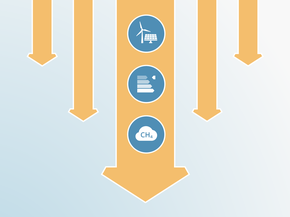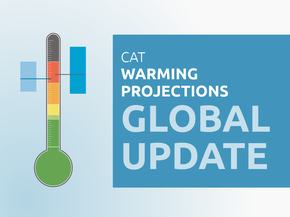Targets
Target Overview
In its NDC, Argentina has set an unconditional target of not exceeding 349 MtCO2e in 2030. This target covers all sectors. The CAT excludes emissions from land use, land use change and forestry from this target and converts it to GWP AR4, resulting in 351 MtCO2e in 2030. To obtain the NDC emissions level excluding LULUCF, the CAT uses a Business-As-Usual (BAU) scenario for the LULUCF sector developed by UNICEN (Keesler & Blanco, 2024). For more details, please see the Assumptions section. The CAT rates this target as “Highly insufficient” both when compared to required domestic efforts, and when compared to Argentina’s fair share.
In November 2022, Argentina submitted a long-term strategy (LTS) to the UNFCCC that includes a target to reach GHG neutrality by 2050 (Government of Argentina, 2022a).
| ARGENTINA — Main climate targets |
|---|
| 2030 NDC target | |||
|---|---|---|---|
| Formulation of target in NDC | Not exceeding net emission of 349 million tons of carbon dioxide equivalent in 2030 (target expressed in SAR GWP) | ||
|
Absolute emissions level in 2030 excl. LULUCF |
351 MtCO2e in 2030 (in AR4 GWP) [9% above 2010] |
||
| Status | Submitted on 02 November 2021 | ||
| Net zero target | |||
|---|---|---|---|
| Formulation of target | Argentina plans to make efforts towards reaching GHG emissions neutrality by 2050 | ||
| Absolute emissions level in 2050 excl. LULUCF | Not disclosed | ||
| Status | Submitted on 06 November 2022 | ||
[NOTE: assumptions made to quantify these targets are included in the Assumptions section]
NDC Updates
Argentina’s 2021 NDC target of 351 MtCO2e in 2030 is just a 3% reduction below the previous target submitted in December 2020, and 29% below its first NDC target. Argentina’s revised NDC covers emissions from all sectors and covers CO2, CH4, N2O, HFCs and PFCs. The country’s first NDC also covered sulphur hexafluoride (SF6).
This new target represents a 9% increase in emissions above 2010 levels (excl. LULUCF).
Although the new target shows a minimal increase in climate mitigation ambition, the NDC and LTS targets still need to be reflected in the short-term with concrete actions and sectoral plans, such as phasing out the exploration and extraction of fossil fuels (e.g. at the Vaca Muerta fossil gas field), eliminating fossil fuel subsidies, and addressing the country’s rising emissions from the AFOLU sector, including agriculture and cattle farming.
| ARGENTINA — History of NDC updates | 2016 NDC | 2020 NDC | 2021 NDC |
|---|---|---|---|
| 1.5°C compatible |
|
|
|
| Stronger target | N/A |
|
|
| Fixed/absolute target |
|
|
|
| ARGENTINA | 2016 NDC | 2020 NDC | 2021 NDC |
|---|---|---|---|
| Formulation of target in NDC | Argentina shall not exceed a net emission of 483 MtCO2e (in SAR GWP). | The Argentine Republic is committed to an absolute, economy wide and unconditional goal of not exceeding net emissions of 359 MtCO2e in 2030 (in SAR GWP). | Argentina’s updated goal is to not exceed net emissions of 349 MtCO2e in 2030 (in SAR GWP). |
|
Absolute emissions level excl. LULUCF |
524 MtCO2e by 2030 (in AR4 GWP) | 385 MtCO2e by 2030 (in AR4 GWP) | 351 MtCO2e by 2030 (in AR4 GWP) |
|
Emissions compared to 1990 and 2010 excl. LULUCF |
53% above 2010 emissions by 2030 | 12% above 2010 emissions by 2030 | 9% above 2010 emissions by 2030 |
| CAT rating |
Overall rating*: Critically insufficient |
NDC target against modelled domestic pathways: Highly Insufficient NDC target against fair share: Highly Insufficient |
NDC target against modelled domestic pathways: Highly Insufficient NDC target against fair share: Highly Insufficient |
| Sector coverage | Economy-wide | Economy-wide | Economy-wide |
| Separate target for LULUCF | No | No | No |
| Gas coverage | CO2, CH4, N2O, HFCs, PFCs, and SF6 | CO2, CH4, N2O, HFCs, and PFCs | CO2, CH4, N2O, HFCs, and PFCs |
| Target type | Absolute emissions limit | Absolute emissions limit | Absolute emissions limit |
* Before September 2021, all CAT ratings were based exclusively on fair share and only assessed a country’s target
Target development timeline & previous CAT analysis
CAT rating of targets
The CAT rates NDC targets against each country’s fair share contribution to global climate change mitigation, considering a range of equity principles including responsibility, capability, and equality. The CAT also rates NDC targets against indicative national emissions from global least-cost emissions pathways (called modelled domestic pathways).
Developing countries like Argentina may need support to achieve emissions reductions in line with a physically required pathway to achieving the 1.5°C long-term temperature goal.
The CAT rates Argentina's target as "Highly insufficient" both when rated against modelled domestic pathways, and when rated against the fair share contribution. Argentina has one NDC target. It has not specified whether a portion of the target is conditional on international support or whether its NDC has an international element, so we rate its NDC target against both frameworks, fairness and modelled domestic pathways.
We rate Argentina’s 2030 NDC target as “Highly insufficient” when compared with modelled domestic emissions pathways, or what Argentina needs to do within its own borders.
The “Highly insufficient” rating indicates that Argentina’s NDC target in 2030 leads to rising, rather than falling, emissions and is not at all consistent with limiting warming to 1.5°C. If all countries were to follow Argentina’s approach, warming could reach over 3°C and up to 4°C by end of the century.
We rate Argentina’s 2030 NDC target as “Highly insufficient” when compared with its fair share contribution to climate action.
The “Highly insufficient” rating indicates that Argentina’s NDC target is not at all consistent with any principle of fairness, like responsibility, capability, or equality. If all countries were to follow Argentina’s approach, warming could reach over 3°C and up to 4°C.
The improvement in the CAT rating for Argentina’s NDC target since our last update, from “Critically insufficient” to “Highly insufficient”, is not due to Argentina submitting a new and stronger NDC target, but rather to a literature update to our fair share (FS) ranges, which aligns our equity approaches with international environmental law (Rajamani et al., 2021) and therefore exclude studies based on cost-effectiveness; we also included additional studies to reflect the latest research available in the field. Therefore, this change of ratings does not represent improved climate action on the ground, compared to our previous assessment.
Further information on how the CAT rates countries (against modelled domestic pathways and fair share) can be found here.
Net zero and other long-term target(s)
We evaluate the net zero target as: Poor.
In November 2022, Argentina submitted a long-term strategy (LTS) to the UNFCCC that includes a target to reach GHG neutrality by 2050 (Government of Argentina, 2022a).
Argentina’s net zero target does not cover most of the good practice elements identified by the CAT net zero methodology. The target explicitly covers all gases and sectors of the economy, but the government fails to disclose other key information such as the role of carbon dioxide removals.
Argentina could improve the target architecture and transparency of its net zero target. For example, the government could set separate emission and reduction targets and clarify its accounting methodology for LULUCF. It could further improve transparency on its planning process, the use of tools such as pathway modelling and specific sectoral policy objectives to reach net zero.
For the full analysis click here.
Further analysis
Latest publications
Stay informed
Subscribe to our newsletter




